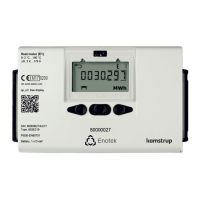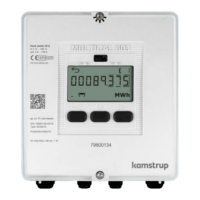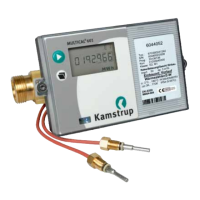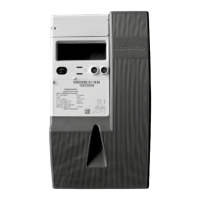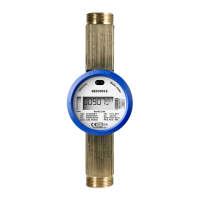MULTICAL® 403
Kamstrup A/S · Technical description · FILE100000166_B_EN-55121689_M1_07.2023
7.10 Summer/winter time adjustment
MULTICAL® 403 is available with configuration for DST (Daylight Saving Time ~ summer/winter time). The meter’s
country code determines the DST-configuration algorithm, so that it corresponds to the DST regulations of the
country, for which the meter is intended. If the meter is configured with DST and you do not want to use it, the DST-
function can be disabled in the PC-program METERTOOL HCW. The DST-function has direct influence on the meter’s
internal clock and time-controlled tariff limits. Time stamps for loggings of events and values are saved in standard
time together with information on the current DST offset. The information on DST offset is removed from all logged
time stamps if the DST-function is disabled in the meter, and vice versa if the DST-function is enabled again.
DST and tariffs: The time-controlled tariff limit follows DST offset. For instance the entered tariff limits will be moved
an hour forward at DST start and an hour backwards at the end of DST (DK example). If the DST function is disabled
after a period in operation, the time limits will follow standard time. Accumulated energy in the tariff registers
remains unchanged, and thus reflects the time limits with enabled DST-function. The same applies visa versa if the
DST-function is reactivated.
DST and loggers: Time stamps for logging will always follow the meter’s configuration. For instance a meter with
enabled DST-function will log data at 00.00 during winter time and at 01.00 a.m. during summer time (DK example).
If the DST-function is disabled after delivery and historical logger values are subsequently read, DST offset of
previous values will reflect the new configuration and be removed from the time stamp. See the example in the
below-mentioned table, read logging times will always reflect the current DST status.
DST and max./min. values Time stamps on logging of max./min. values follow standard time. If the time stamp of a
value is read, it will be stated with current DST offset. If the DST-function is disabled after delivery, DST offset will be
removed from the time stamps of historical values as it is done with the loggers.
DST and serial read-out of logging data: Data can either be read from a register including time in standard time and
DST offset as two separate parameters, or alternatively from a register including time comprising DST offset as a
parameter. If the DST-function is disabled after delivery, information on DST offset will be removed from time
stamps related to the historical values.

